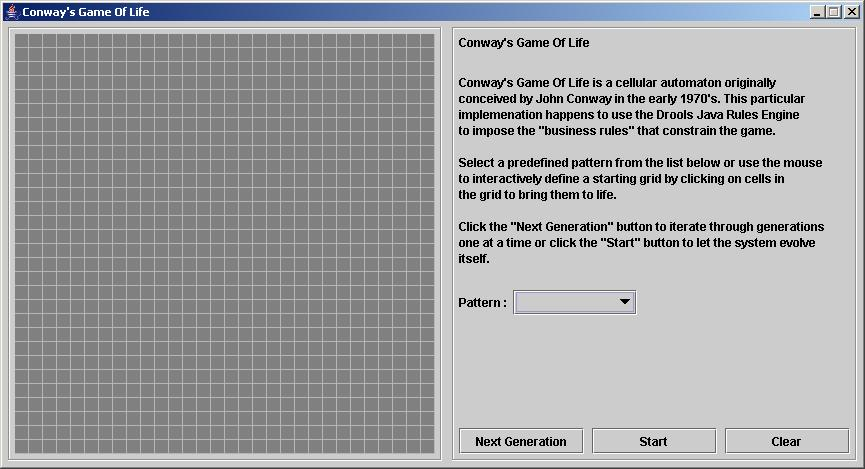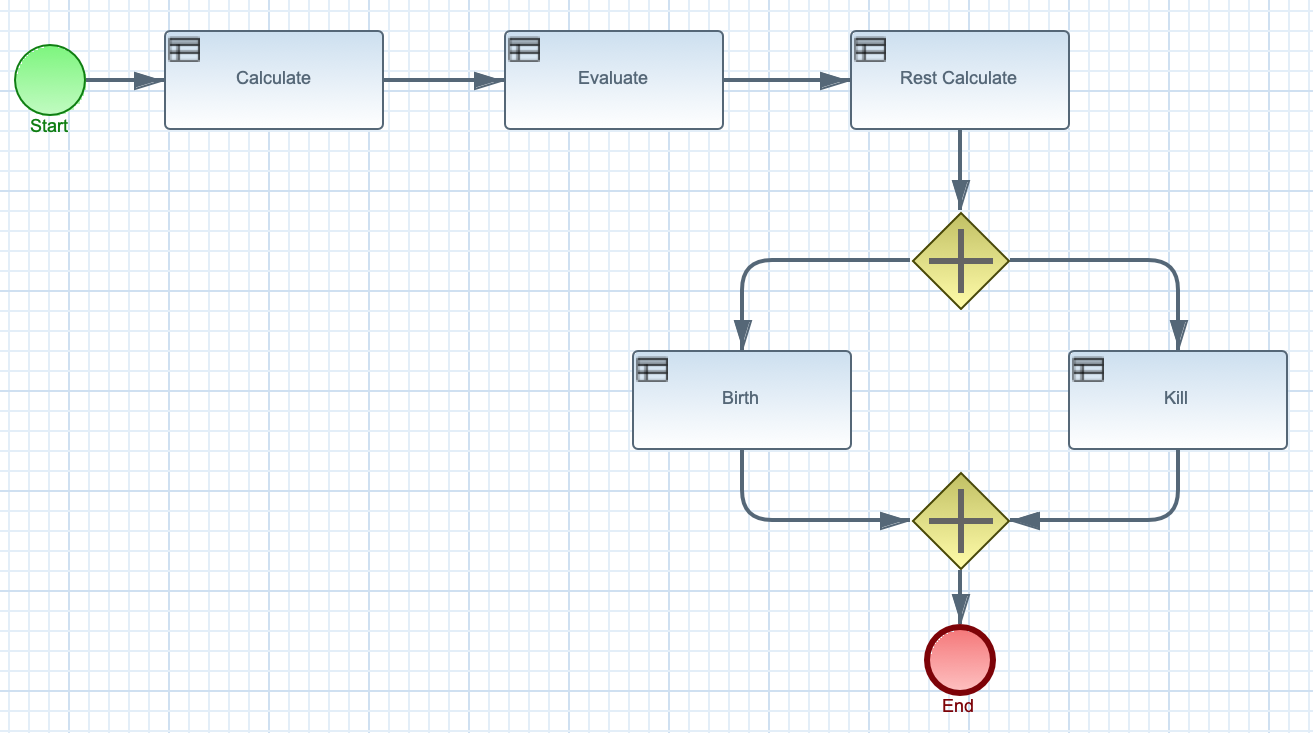87.9. Conway’s Game of Life example decisions (ruleflow groups and GUI integration)
The Conway’s Game of Life example decision set, based on the famous cellular automaton by John Conway, demonstrates how to use ruleflow groups in rules to control rule execution. The example also demonstrates how to integrate Red Hat Decision Manager rules with a graphical user interface (GUI), in this case a Swing-based implementation of Conway’s Game of Life.
The following is an overview of the Conway’s Game of Life (Conway) example:
-
Name:
conway -
Main classes:
org.drools.examples.conway.ConwayRuleFlowGroupRun,org.drools.examples.conway.ConwayAgendaGroupRun(insrc/main/java) -
Module:
droolsjbpm-integration-examples - Type: Java application
-
Rule files:
org.drools.examples.conway.*.drl(insrc/main/resources) - Objective: Demonstrates ruleflow groups and GUI integration
The Conway’s Game of Life example is separate from most of the other example decision sets in Red Hat Decision Manager and is located in ~/rhdm-7.10.0-sources/src/droolsjbpm-integration-$VERSION/droolsjbpm-integration-examples of the Red Hat Decision Manager 7.10.0 Source Distribution from the Red Hat Customer Portal.
In Conway’s Game of Life, a user interacts with the game by creating an initial configuration or an advanced pattern with defined properties and then observing how the initial state evolves. The objective of the game is to show the development of a population, generation by generation. Each generation results from the preceding one, based on the simultaneous evaluation of all cells.
The following basic rules govern what the next generation looks like:
- If a live cell has fewer than two live neighbors, it dies of loneliness.
- If a live cell has more than three live neighbors, it dies from overcrowding.
- If a dead cell has exactly three live neighbors, it comes to life.
Any cell that does not meet any of those criteria is left as is for the next generation.
The Conway’s Game of Life example uses Red Hat Decision Manager rules with ruleflow-group attributes to define the pattern implemented in the game. The example also contains a version of the decision set that achieves the same behavior using agenda groups. Agenda groups enable you to partition the decision engine agenda to provide execution control over groups of rules. By default, all rules are in the agenda group MAIN. You can use the agenda-group attribute to specify a different agenda group for the rule.
This overview does not explore the version of the Conway example using agenda groups. For more information about agenda groups, see the Red Hat Decision Manager example decision sets that specifically address agenda groups.
Conway example execution and interaction
Similar to other Red Hat Decision Manager decision examples, you execute the Conway ruleflow example by running the org.drools.examples.conway.ConwayRuleFlowGroupRun class as a Java application in your IDE.
When you execute the Conway example, the Conway’s Game of Life GUI window appears. This window contains an empty grid, or "arena" where the life simulation takes place. Initially the grid is empty because no live cells are in the system yet.
図87.24 Conway example GUI after launch

Select a predefined pattern from the Pattern drop-down menu and click Next Generation to click through each population generation. Each cell is either alive or dead, where live cells contain a green ball. As the population evolves from the initial pattern, cells live or die relative to neighboring cells, according to the rules of the game.
図87.25 Generation evolution in Conway example

Neighbors include not only cells to the left, right, top, and bottom but also cells that are connected diagonally, so that each cell has a total of eight neighbors. Exceptions are the corner cells, which have only three neighbors, and the cells along the four borders, with five neighbors each.
You can manually intervene to create or kill cells by clicking the cell.
To run through an evolution automatically from the initial pattern, click Start.
Conway example rules with ruleflow groups
The rules in the ConwayRuleFlowGroupRun example use ruleflow groups to control rule execution. A ruleflow group is a group of rules associated by the ruleflow-group rule attribute. These rules can only fire when the group is activated. The group itself can only become active when the elaboration of the ruleflow diagram reaches the node representing the group.
The Conway example uses the following ruleflow groups for rules:
-
"register neighbor" -
"evaluate" -
"calculate" -
"reset calculate" -
"birth" -
"kill" -
"kill all"
All of the Cell objects are inserted into the KIE session and the "register …" rules in the ruleflow group "register neighbor" are allowed to execute by the ruleflow process. This group of four rules creates Neighbor relations between some cell and its northeastern, northern, northwestern, and western neighbors.
This relation is bidirectional and handles the other four directions. Border cells do not require any special treatment. These cells are not paired with neighboring cells where there is not any.
By the time all activations have fired for these rules, all cells are related to all their neighboring cells.
Rules "register …"
rule "register north east"
ruleflow-group "register neighbor"
when
$cell: Cell( $row : row, $col : col )
$northEast : Cell( row == ($row - 1), col == ( $col + 1 ) )
then
insert( new Neighbor( $cell, $northEast ) );
insert( new Neighbor( $northEast, $cell ) );
end
rule "register north"
ruleflow-group "register neighbor"
when
$cell: Cell( $row : row, $col : col )
$north : Cell( row == ($row - 1), col == $col )
then
insert( new Neighbor( $cell, $north ) );
insert( new Neighbor( $north, $cell ) );
end
rule "register north west"
ruleflow-group "register neighbor"
when
$cell: Cell( $row : row, $col : col )
$northWest : Cell( row == ($row - 1), col == ( $col - 1 ) )
then
insert( new Neighbor( $cell, $northWest ) );
insert( new Neighbor( $northWest, $cell ) );
end
rule "register west"
ruleflow-group "register neighbor"
when
$cell: Cell( $row : row, $col : col )
$west : Cell( row == $row, col == ( $col - 1 ) )
then
insert( new Neighbor( $cell, $west ) );
insert( new Neighbor( $west, $cell ) );
end
After all the cells are inserted, some Java code applies the pattern to the grid, setting certain cells to Live. Then, when the user clicks Start or Next Generation, the example executes the Generation ruleflow. This ruleflow manages all changes of cells in each generation cycle.
図87.26 Generation ruleflow

The ruleflow process enters the "evaluate" ruleflow group and any active rules in the group can fire. The rules "Kill the …" and "Give Birth" in this group apply the game rules to birth or kill cells. The example uses the phase attribute to drive the reasoning of the Cell object by specific groups of rules. Typically, the phase is tied to a ruleflow group in the ruleflow process definition.
Notice that the example does not change the state of any Cell objects at this point because it must complete the full evaluation before those changes can be applied. The example sets the cell to a phase that is either Phase.KILL or Phase.BIRTH, which is used later to control actions applied to the Cell object.
Rules "Kill the …" and "Give Birth"
rule "Kill The Lonely"
ruleflow-group "evaluate"
no-loop
when
// A live cell has fewer than 2 live neighbors.
theCell: Cell( liveNeighbors < 2, cellState == CellState.LIVE,
phase == Phase.EVALUATE )
then
modify( theCell ){
setPhase( Phase.KILL );
}
end
rule "Kill The Overcrowded"
ruleflow-group "evaluate"
no-loop
when
// A live cell has more than 3 live neighbors.
theCell: Cell( liveNeighbors > 3, cellState == CellState.LIVE,
phase == Phase.EVALUATE )
then
modify( theCell ){
setPhase( Phase.KILL );
}
end
rule "Give Birth"
ruleflow-group "evaluate"
no-loop
when
// A dead cell has 3 live neighbors.
theCell: Cell( liveNeighbors == 3, cellState == CellState.DEAD,
phase == Phase.EVALUATE )
then
modify( theCell ){
theCell.setPhase( Phase.BIRTH );
}
end
After all Cell objects in the grid have been evaluated, the example uses the "reset calculate" rule to clear any activations in the "calculate" ruleflow group. The example then enters a split in the ruleflow that enables the rules "kill" and "birth" to fire, if the ruleflow group is activated. These rules apply the state change.
Rules "reset calculate", "kill", and "birth"
rule "reset calculate"
ruleflow-group "reset calculate"
when
then
WorkingMemory wm = drools.getWorkingMemory();
wm.clearRuleFlowGroup( "calculate" );
end
rule "kill"
ruleflow-group "kill"
no-loop
when
theCell: Cell( phase == Phase.KILL )
then
modify( theCell ){
setCellState( CellState.DEAD ),
setPhase( Phase.DONE );
}
end
rule "birth"
ruleflow-group "birth"
no-loop
when
theCell: Cell( phase == Phase.BIRTH )
then
modify( theCell ){
setCellState( CellState.LIVE ),
setPhase( Phase.DONE );
}
end
At this stage, several Cell objects have been modified with the state changed to either LIVE or DEAD. When a cell becomes live or dead, the example uses the Neighbor relation in the rules "Calculate …" to iterate over all surrounding cells, increasing or decreasing the liveNeighbor count. Any cell that has its count changed is also set to the EVALUATE phase to make sure it is included in the reasoning during the evaluation stage of the ruleflow process.
After the live count has been determined and set for all cells, the ruleflow process ends. If the user initially clicked Start, the decision engine restarts the ruleflow at that point. If the user initially clicked Next Generation, the user can request another generation.
Rules "Calculate …"
rule "Calculate Live"
ruleflow-group "calculate"
lock-on-active
when
theCell: Cell( cellState == CellState.LIVE )
Neighbor( cell == theCell, $neighbor : neighbor )
then
modify( $neighbor ){
setLiveNeighbors( $neighbor.getLiveNeighbors() + 1 ),
setPhase( Phase.EVALUATE );
}
end
rule "Calculate Dead"
ruleflow-group "calculate"
lock-on-active
when
theCell: Cell( cellState == CellState.DEAD )
Neighbor( cell == theCell, $neighbor : neighbor )
then
modify( $neighbor ){
setLiveNeighbors( $neighbor.getLiveNeighbors() - 1 ),
setPhase( Phase.EVALUATE );
}
end

